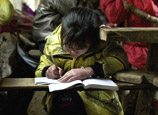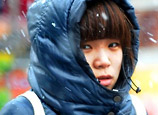
 |
| Students line up for lunch at Mahuangshan elementary school in Ningxia's Yanchi county. |
In 2012, Zhang and her husband obtained a loan of 20,000 yuan and bought 30 sheep. With help from the village administration, they learned about herding and now hope the animals will bring in an extra 20,000 yuan at the end of the year.
"The donations won't last long. We need skills or ideas for a small business, anything that will help us get out of poverty," she said.
More than 2.5 million people, 41 percent of Ningxia's population, live in the region's southern mountainous area, where the extreme conditions resulted in the United Nations listing it as one of the world's most inhospitable places in the 1970s. More than 1 million people officially live in poverty and require a considerable amount of aid every year.
However, the locals and the government are looking for a more sustainable means of poverty relief than charity can provide.
In common with many rural residents on Ningxia's Loess plateau, Zhang's family lives in caves excavated by their forebears a century ago. The two 20-square-meter caves are used as bedrooms, a living room and kitchen.
















 Sex case leads to warnings about apps on smartphones
Sex case leads to warnings about apps on smartphones


![]()
